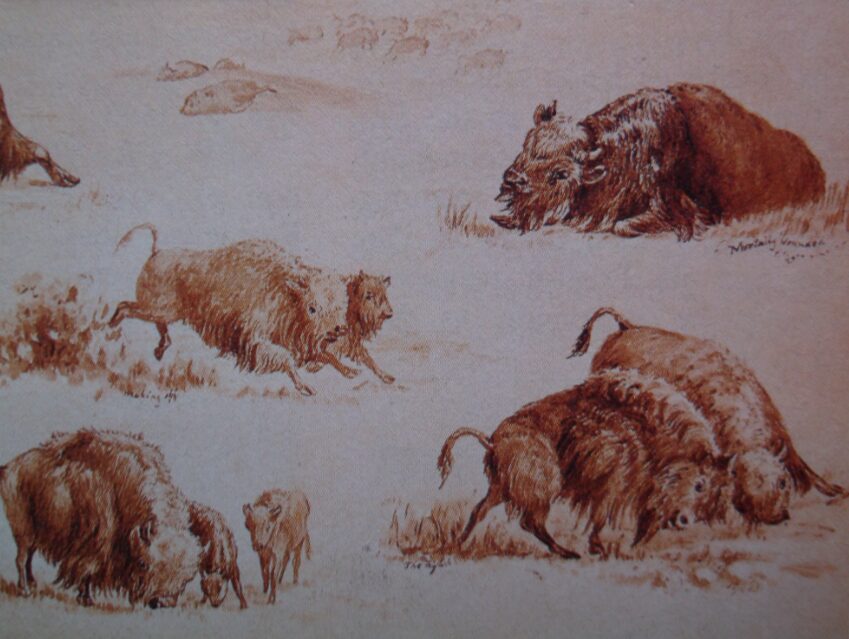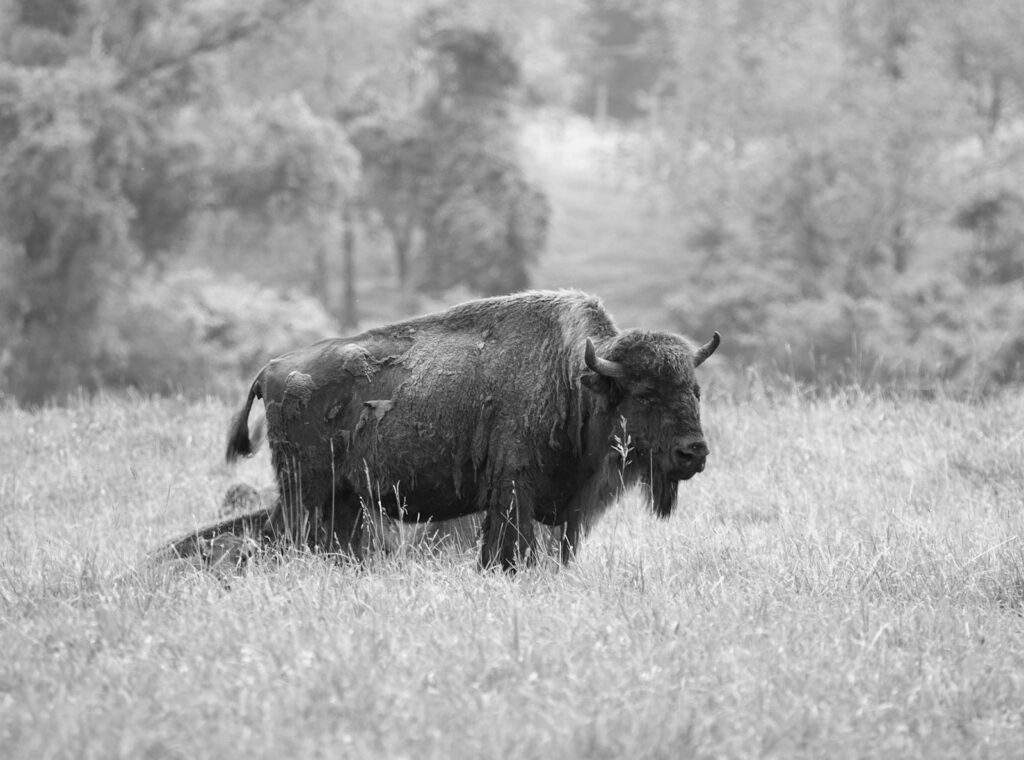Finan “the Buffalo,” McDonald
Glengarry County’s history is populated with larger than life figures. No story is more fantastic, but true than that of the “wrestling” match between fur trader Finan (or Finnan) McDonald and a buffalo, on the banks of the North Saskatchewan River, in 1823.
Remarkably, this battle between man and buffalo was seen by two eye witnesses hunting buffalo with Finan.
Fur trader Edward Ermatinger, wrote that when Finan fired at a buffalo and missed it became so enraged that it “rushed toward” his tormentor “with the utmost impetuosity,” causing Finan’s horse to stumble and throw him on the ground.
Finan raced towards some trees for protection but, “…before he reached (them) he became out of breath and threw himself down trusting to fate. The first blow the animal gave him he tossed him with great violence and gored the most fleshy part of his thigh nearly to the bone. Mr. McD., after this seized him by the wool of his head and held him for some time, but the immense power of the animal obliged him to quit his hold” dislocating his wrist. “He remembers having received six blows, one which was so dreadful that the whole side is bruised black and blue and some of his ribs appear to be broken – the last furious butt made him call out, and what is very strange the Bull at the same instant fell down as if a ball (musket) had struck him.”
“In this state they both remained for above an hour,” while one of the hunting party ran for help.
A gun now went off accidentally and the buffalo galloped off after “attentively” eyeing everyone for a moment, leaving Finan:
“…gored up in many places and covered with blood – A shot pouch which Mr. McD. wore on his left side, made of thick sealskin, covered with porcupine quills and stuffed with rags…for wadding, was found to be pierced thro’ and thro’ and must have saved his life…”
Scottish botanist David Douglas now “Gave him 25 drops of laudanum which produced sleep, and we carried him to the boats,” with two broken ribs and numerous injuries to eventual recovery.
From accounts it would seem that Finan was the “ideal” man to fight an 800 kg plus bull buffalo.
Fellow fur trader Ross Cox wrote that his “…appearance was very striking: in height he was six foot four inches, with broad shoulders, large bushy whiskers and red hair, which for some years had not felt the scissor, and which sometimes falling over his face and shoulders gave a wild and uncouth appearance.”
Cox continued: “To the gentleness of a lamb he united the courage of a lion…but if any man approaching his own attitude presumed to encroach too far on his good nature, a lowering look and distended nostrils warned the intruder of an approaching eruption.”
His bulk and size, according to eminent Glengarry fur trade historian Hugh MacMillan made McDonald “a born wrestler,” who while hunting for wild horses would “…race alongside a likely looking horse, leap from his saddle, grapple the horse to the ground by twisting its head down, then hold on until,” his partners took the horse away.
The young Finan arrived in Glengarry with his family from Scotland in 1786. An unenthusiastic student, he joined his brother to become a fur trader for the North West Company.
Fluent in English and Gaelic, sprinkled with some French and a variety of Indigenous languages, he traded in present day Montana and Washington States. Amongst the various tribes he became known as the “Big Red Chief,” due to his size. In Montana he married Marguerite “Peggy” Pend d’Oreille, (aka Penderay), a name believed to be the shortening of the French words for earrings, “pendant d’oreille.” Peggy apparently was given this name as the daughter of Kalispel Chief Chin-Nay-Way, who was fond of wearing “fur trade” silver jewellery.
Finan continued in the fur trade after the Nor’Westers merged with the Hudson’s Bay Company. Remaining a back woodsman, he did not fit the Bay’s idea of a clerk and Company officials boorishly described Finan as “not too bright and better for dangerous service.”
In 1827, Finan, retired to the burgeoning settlement of former Nor’Westers around Williamstown, with his wife and as many as five of their eleven children to farm. Here, unlike many fur traders who had taken “country” wives, he remarried Peggy at St. Raphael’s in 1830.
Neither Finan or Peggy adjusted to this new sedentary way of life, Peggy “…described as a dear little woman…never understood farming or chairs, or teacups, corsets and all other oddities of white culture,” and after 14 unhappy years died here at age 43, in 1841. She was buried in St. Raphael’s.
The ever restless Finan became involved in financial legal trouble and was jailed in Toronto in 1849, to be eventually released to return to Glengarry where he died in 1851 and was buried in St. Raphael’s.
Sadly his tombstone no longer exists, but his son Donald tried to preserve his father’s memory by donating a holy water font to St. Mary’s in Williamstown.

(photo 1 – and caption.) Early 19th century depictions of prairie buffalo. Two hundred years ago it is estimated that between 30 and 60 million buffalo inhabited North America’s prairies. Over hunting for food and “sport” nearly led to their extinction and today it is estimated that there are 2,200 plains buffalo and 10,000 wood buffalo. (Courtesy, Library Archives Canada, C1055.)

(photo 2 – and caption) A 19th century buffalo hunter. (Courtesy, Library Archives Canada, C31264.)





